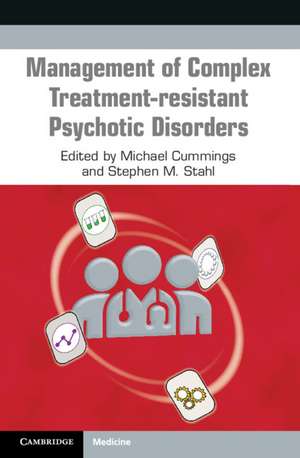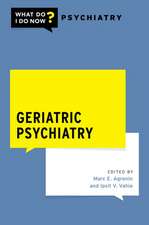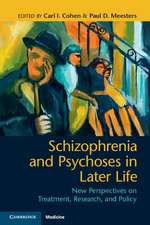Management of Complex Treatment-resistant Psychotic Disorders
Editat de Michael Cummings, Stephen Stahlen Limba Engleză Paperback – 21 iul 2021
Preț: 314.28 lei
Preț vechi: 330.81 lei
-5% Nou
Puncte Express: 471
Preț estimativ în valută:
60.13€ • 63.12$ • 49.91£
60.13€ • 63.12$ • 49.91£
Carte disponibilă
Livrare economică 20 martie-03 aprilie
Livrare express 06-12 martie pentru 46.43 lei
Preluare comenzi: 021 569.72.76
Specificații
ISBN-13: 9781108965682
ISBN-10: 1108965687
Pagini: 538
Dimensiuni: 137 x 227 x 23 mm
Greutate: 0.78 kg
Ediția:Nouă
Editura: Cambridge University Press
Colecția Cambridge University Press
Locul publicării:Cambridge, United Kingdom
ISBN-10: 1108965687
Pagini: 538
Dimensiuni: 137 x 227 x 23 mm
Greutate: 0.78 kg
Ediția:Nouă
Editura: Cambridge University Press
Colecția Cambridge University Press
Locul publicării:Cambridge, United Kingdom
Cuprins
Part I. Treatment Strategies: 1.01. Approaches to positive Psychotic symptoms; 1.02. Use of plasma levels in Antipsychotic and Mood Stabilizer treatment; 1.03. Advantages of long-acting injectable Antipsychotics; 1.04. Approach to Schizophrenia Spectrum treatment-resistant patients; 1.05. Approach to depressed or suicidal Schizophrenia Spectrum patients; 1.06. Approach to persistent aggression and violence in Schizophrenia Spectrum Disorders; 1.07. Approach to treatment of Bipolar Diathesis in Schizophrenia Spectrum patients; 1.08. Approach to Anxiety in Schizophrenia Spectrum patients; 1.09. Approach to Insomnia and Sleep Disturbance in Schizophrenia Spectrum disorders; 1.10. Approach to Psychosis in children and adolescents; 1.11. Electro-convulsive therapy and other Non-pharmacological treatments; 1.12. Approach to substance use disorders in Schizophrenia Spectrum Disorders; 1.13. Approaches to Behavioral Disturbances and Dementia and TBI patients; Part II. Medication Reference Tables: First-generation (Typical) Antipsychotics: 2.01. Chlorpromazine; 2.02. Fluphenazine; 2.03. Haloperidol; 2.04. Loxapine; 2.05. Perphenazine; 2.06. Thiothixene; 2.07. Trifluoperazine; Second-generation (Atypical) Antipsychotics: 2.08. Asenapine; 2.09. Clozapine; 2.10. Iloperidone; 2.11. Lumateperone; 2.12. Lurasidone; 2.13. Olanzapine; 2.14. Paliperidone; 2.15. Quetiapine; 2.16. Risperidone; 2.17. Ziprasidone; Dopamine Partial Agonist Antipsychotics (Arias): 2.18. Aripiprazole; 2.19. Brexpiprazole; 2.20. Cariprazine; Medications for Motor/Neurologic Adverse Effects: 2.21. Amantadine; 2.22. Benztropine; 2.23. Diphenhydramine; 2.24. Trihexyphenidyl; Mood Stabilizers: 2.25. Carbamazepine; 2.26. Lamotrigine ; 2.27. Lithium; 2.28. Valproic Acid; Selective Serotonin Reuptake Inhibitor (SSRI) Antidepressants: 2.29. Citalopram; 2.30. Escitalopram; 2.31. Fluoxetine; 2.32. Fluvoxamine; 2.33. Paroxetine; 2.34. Sertraline: SSRI/5HT-1 Partial Agonist Antidepressants: 2.35. Vilazodone; 2.36. Vortioxetine; Serotonin/Norepinephrine Reuptake Inhibitor (SNRI) Antidepressants; 2.37. Desvenlafaxine; 2.38. Duloxetine; 2.39. Levomilnacipran; 2.40. Venlafaxine; Mixed Mechanism Antidepressants: 2.41. Bupropion; 2.42. Mirtazapine; 2.43. Trazodone; Tricyclic Antidepressants: 2.44. Amitriptyline; 2.45. Clomipramine; 2.46. Desipramine; 2.47. Doxepin; 2.48. Imipramine; 2.49. Nortriptyline; Monoamine Oxidase Inhibitor (MAOI) Antidepressants: 2.50. Isocarboxazid; 2.51. Moclobemide; 2.52. Phenelzine; 2.53. Transdermal Segeliline; 2.54. Tranylcypromine; Anxiolytics: 2.55. Alprazolam; 2.56. Buspirone; 2.57. Clonazepam; 2.58. Diazepam; 2.59. Hydroxyzine; 2.60. Lorazepam; Sedatives: 2.61. Diphenhydramine; 2.62. Eszopiclone; 2.63. Hydroxyzine; 2.64. Lorazepam; 2.65. Oxazepam; 2.66. Temazepam; 2.67. Zaleplon; 2.68. Zolpidem; Circadian Regulators: 2.69. Melatonin; 2.70. Ramelteon; 2.71. Tasimelteon; Stimulants: 2.72. Atomoxetine; 2.73. Dextroamphetamine; 2.74. Lisdexamphetamine; 2.75. Methylphenidate; 2.76. Mixed Amphetamine Salts: Histaminic Stimulants: 2.77. Armodafinil; 2.78. Modafinil; Cognitive Agents: 2.79. Dextromethorphan/quinidine; 2.80. Donepizil; 2.81. Galantamine; 2.82. Memantine; 2.83. Rivastigmine; Alpha2-adrenergic Agonists: 2.84. Clonidine; 2.85. Guanfacine; Appendices: 3.01. Optimal Antipsychotic Plasma Concentration Ranges; 3.02. Optimal Mood Stabilizer Plasma Concentration Ranges; 3.03. Formulas for QT Interval Correction; 3.04. Common Cytochrome P-450 Inducers and Inhibitors; 3.05. Management of Constipation; 3.06. Child-Pugh Hepatic Function Scoring; 3.07. Loading of Lithium and Valproic Acid; 3.08. Treatment of Prolactin Elevation; 3.09. A Select List of Foods High in Tyramine; 3.10. Medications that Present Risk for Serotonin Syndrome when Combined with MAOIs; 3.11. Selected Treatment of Psychomotor Agitation.
Recenzii
'The book is clearly useful for medical students, residents, and young psychiatrists.' Michael Easton, Doody's Notes
Descriere
An essential handbook providing practical guidance and medication advice on the effective management and treatment of psychotic disorders.


